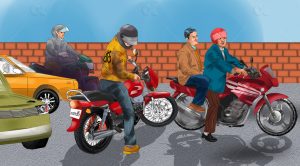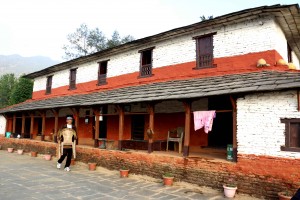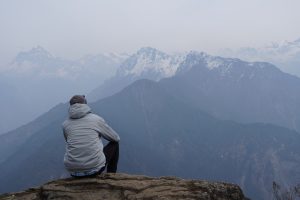Going to Pharping from Kathmandu feels like going back in time, from the city’s sorry present to its rich past. The transformation of the city into the countryside begins somewhere after Tribhuvan University. An old iron bridge, soot-black, spans a weary river of the same color.
Going past this bridge I feel like I’ve escaped the clutches of the city. A huge standing Buddha statue appears around the next bend on the road, the face childish. The escape is complete when the road loops into a pine forest.
When the mottled stretch of the road through the pine forest ends, you arrive in the Nepali film industry’s favorite filming destination. It’s easy to understand why. It’s an outdoors location mere kilometers from Kathmandu. For a tiny budget filmmakers have in their frame secluded hilltops and a desolate stone quarry pit—places they can easily present as some remote corner of Nepal.
It’s a place to linger if you are out on a weekend trip. There is the Chobar gorge (an old shaky bridge spanning it) and the somewhat conciliatory sight of the Bagmati flowing with some vigor, although yet not strong enough to shake off Kathmandu’s cargo of filth. You can crawl into caves or pass through the doors of the Jal Binayak Temple here.
(Left to right) Jal Binayak temple on a winter morning; Photo Wikimedia Commons. Taudaha lake is frequented by migratory birds and lovebirds; Photo: Wikimedia Commons. Chakati, or mat, made from corn husk at Chobar’s De´Cafe Old House; Photo: Bhuwan Maharjan/Flickr. (Opener) A foggy morning at Jal Binayak; Photo: Bhuwan Maharjan/Flickr
But travel beyond Chobar and you are deeper into the countryside. The parts of the Kathmandu Valley that are visible from here have more green than concrete. Then you arrive at Taudaha, the lake frequented by migratory birds and lovebirds. Across it, terraced fields tumble down to the Bagmati.
The houses are of adobe, golden garlands of corn ears strung from eaves to eaves. Higher up, near the summit of a hill a monastery nestles, conspicuous because of its prayer flags. Eagles wheel overhead, scanning the hills that are so densely forested that it appears they are covered not in trees but by one great swath of green carpet.
The last third of the road to Pharping is like a metaphorical road to spirituality—as propounded in Tibetan Buddhism, to be precise. Monasteries with yellow roofs and whitewashed facades appear frequently beside the road. The biggest of them appears first, at a place called Bhanjhyang (a pass in the hills), effectively making the pass a gateway to a region caught in a monastery building boom. There is a reason for this abundance of monasteries and temples.
Pharping is mentioned in numerous religious texts as a highly sacred region, one that even great spiritual masters traveled to from as far as Tibet in ancient times. Even Padmashambhava, or Guru Rinpoche, the doyen of Tibetan Buddhism, is said to have stayed here and meditated.

Inside a monastery in Pharping; Photo: Wonderlane/Flickr.
The Sheshnarayan Temple complex is a site where mythology is etched on the cliffs, literally. This is one of four major Narayan (Vishnu) temples of the Kathmandu Valley. The temple’s major attraction is a knobby bunch of stalactites that people worship as the udder of a cow.
Old timers recall their grandparents telling them of a time when milk dripped from these teats. Just above the udder is a serpentine formation, hood flared like the classic seven-headed sheshnag of Hindu mythology. The temple is named after this formation.
More eye-catching than the stalactites is a crystal clear pond. Colorful fish swim languidly in this spring, gobbling up food that visitors feed them. At the bottom of this pond are several slender wooden poles covered in moss. They are the result of an annual ritual that the local community performs to commemorate an event from mythology.
According to folklore, when the priest of Sheshnarayan Temple became too old to walk downhill to the Bagmati River to fetch water for the daily puja, he prayed for help. A spring appeared and there was water, but the volume of water gushing out was so large that there soon flowed a swift river between the priest’s house and the temple. A pair of nags (snakes) stretched themselves across this river to form a bridge for the priest. In remembrance of the two nags locals select a tree with two boughs forking from the trunk, a symbolic union of two snakes, and throw it into the pond.

(Left to Right) An udder-like stalactites hanging over the Sheshnarayan temple; Photo: Wonderlane/Flickr. One of the statues stands half immersed in one of the seven ponds at Sheshnarayan temple; Photo: Wikimedia Commons. A statue of Uma-Maheshwor at the Sheshnarayan temple complex; Photo: Kapil Bisht.
Equally sacred is the Rigzin Drubte Ghatshal, Pharping’s oldest monastery. The building itself is something of a recluse, tucked back under the cliff, away from the sun’s brightness, behind a screen of trees. It’s small and simply colored. But when you climb the small stairs from the pond to the monastery, it becomes clear that it’s not about appearances but something deeper. Perhaps this seclusion was what made Padmasambhava stay here and meditate in a small cave. The cave (so the local legend goes) is still there. A small circular cavity in the roof of this tiny cave is believed to be the imprint of Guru Rinpoche’s head.
Pharping Bazar is a curve and a climb on the road from the Sheshnarayan Temple. The place has the look of a village’s half-hearted attempt at urbanization, as though it felt obliged to keep up with transformation happening down in the Kathmandu Valley. The concrete houses are like a screen for old Newar style exposed brick houses, with cows in stables and hay stacks in the courtyard.
Arriving at Pharping Bazar is an abrupt change, and seeing shops and mannequins and cyber cafes you wonder if you have exhausted the ancient shrines and quaint places. But the road forks at Pharping Bazar.
Both roads go to a place of worship; the one going south takes you to Dakshinkali and the north road passes by the Ngagyur-Nyingmapa Rigzin Phodrang Monastery. And once again you find yourself at the entrance to a place that is sacred and ancient, with a story or two attached to it.
Checklist
Getting There

There are frequent buses from the Old Bus Park for Pharping. The ride costs 30 rupees. If you are on a private vehicle, cross the Ring Road at Balkhu toward Tribhuvan University. Continue straight down this road, past the university’s entrance gate. Pharping Bazar is almost 19 km from the Old Bus Park.
While in Pharping

Sacred Stops
The monastery at Bhanjhyang; Photo: Kapil Bisht.
The sites here are given in the order in which they appear on the road to Pharping. While in these places, please remember to maintain silence and behave in a way appropriate to places of worship and retreat.
Seti Devi Temple
This small shrine is easily missed because it is behind the gigantic monastery at Bhanjhyang. (Bhanjhyang is 16 km from the Old Bus Park). To get here, take the graveled road that skirts the monastery’s western wall. This road is only wide enough for two-wheelers; leave your four-wheelers at the Bhanjhyang market. After 400 meters you will arrive at the base of a flight of stone stairs. These lead to the temple. The temple’s sacredness is not its only attraction. There are sweeping views of Kathmandu and Pharping from here.
Roofless Temple
Near the northern entrance (the flagstone trail between the lower fish pond) is a small doorway that leads into an abandoned-looking courtyard. In the middle of this courtyard is a humble temple, ordinary save for the fact that it has no roof. That is not because of the earthquake or any other natural calamity; the temple was designed that way. According to local lore, the idol housed there was brought over from India. The god, yearning for his homeland, is believed to make nightly trips to India. So the temple was made without a roof to ease the god’s departure and return.
Ganesh-Saraswati Temple
Climbing up the flight of steep steps to the Rigzin Phodrang Monastery, you will see a small room opposite a prayer hall. This is the Ganesh-Saraswati Temple. There are small images of Ganesh and Saraswati embossed on the rock here, both of which are said to have materialized from the rock face on their own. Buddhists also come here to worship the Saraswati image, although to them it is the goddess Green Tara.
Asura Cave and Old Dakshinkali Temple
There is another cave in Pharping where Padmashambhava is said to have meditated. The cave is Asura Cave. The cave is situated in the premises of the Ngagyur-Nyingmapa Rigzin Phodrang Monastery. The monastery is a couple of hundred meters down the road that forks right (west) from Pharping Bazar. A climb to the summit of the hill with the monastery and cave will bring you to the original site of the Dakshinkali shrine. It was from here that the shrine was moved to its current location.
‘Secular’ Sights
The hydropower station at Pharping first produced electricity in 1911. Photo: Bhuwan Maharjan/Flickr.
Hydropower Station
It will send a minor shock through your system to know that this hydropower station first produced electricity in 1911. This is a museum of sorts, with its hulking machinery parts, embossed with dates from the past century. There are one or two electric pylons here that date back to the year of this station’s completion. It’s worth a try to ask the staff working there to let you into the cavernous turbine room. If you’re lucky, they might decide to turn on the turbines for you, which is akin to watching a Megatron come to life. While you are there, check out the park built to commemorate the station’s centenary and the old reservoir.
Bottle House
At first sight the Environment-Friendly Bottle House looks like an alcohol connoisseur’s handiwork. The walls are covered in whiskey and beer bottles—all empty. Some 5000 empty bottles have been used to build two houses that serve as a farmers’ school and community meeting hall. To get there, take the south road from Pharping Bazar.
Head 400 meters on this road. There, on the left, you will see a board pointing down a steep trail. It’s best not to take your motorbike down this trail in the monsoon. This unique building is the work of Shikharapur Community Learning Centre. They hold recreational events like rice-planting and other farming-related activities. The farm also takes volunteers. To learn more, visit asc.org.np, shikharapurclc.edu.np, and Asc Pharping (Facebook).
Where to Stay

Family Guest House is a good option if you want to stay close to the town’s center. Options farther away from the crowded part of town include Hotel Ashoka and Dakchhinkali Village Inn.
Eat

The road west from Pharping Bazar is lined with restaurants. Sikkim Restaurant is highly recommended for its delicious momos, vegetable thukpa, fried potatoes and the prohibitively fiery tomato chutni. Opposite this eatery is The Himalayan Restaurant, whose rooftop thatch-roof huts are the best location to take in the bucolic sights from while munching on snacks.
***
More by the author
Kakani: Just outside Kathmandu, this village comes to life at night
Silhouettes and Silence in Nepal’s Begnas Lake
Finding Nature’s long-lost music and motion in Kathmandu’s monsoon


























